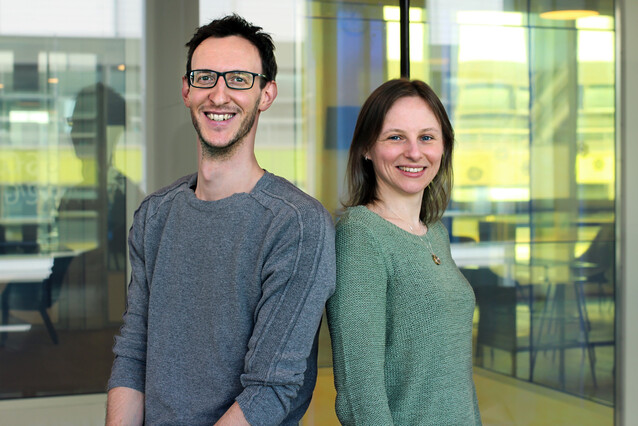Milestone in understanding regulation of gene transcription
The expression of our genes is tightly regulated by the action of enhancers, DNA sequences that activate the transcription of a gene into messenger RNA. Enhancers recruit a host of proteins and were long thought to require the action of the same cofactor proteins to work, making the transcription machinery highly vulnerable to disturbance. Scientists at the IMP challenged this idea and found that enhancers linked to some vital genes function without broadly utilised cofactors - they activate transcription through alternative mechanisms. The findings are now published in the journal Nature.
The human body contains hundreds of different cell types, from neurons to skin cells, muscle cells, and immune cells. Within an individual, all these cells carry the same genome and its 20,000 genes, but differ in the way they make use of these genes. Adjusting where and when specific genes are activated, or ‘expressed’, allows different cells to develop different morphologies and functions.
Genes, the blueprints for proteins, make up only one to two percent of the human genome. The rest is not directly used to produce proteins, but in part determines the where and when of transcription - the process of ‘reading’ a gene and converting the information into messenger RNA before the encoded protein is produced. The master regulators of transcription are enhancers, DNA sequences that play the role of on-off switches on gene expression. Enhancers work by binding proteins called transcription factors, which recruit other proteins, or cofactors, to activate transcription when needed.
For decades, scientists have thought that all enhancers needed an identical set of cofactors to function, including the large Mediator complex and the bromodomain-containing protein 4 (BRD4).
A team of scientists led by the lab of Alex Stark at the IMP studied how the absence of specific cofactors affects enhancer activity across the entire human genome. To do so, the scientists combined two powerful tools. The first is STARR-seq, a technology developed at the IMP and published in 2013, which identifies enhancers and measures their activity across entire genomes. The second tool is based on tagging a protein of interest with a label that allows its rapid degradation – once a cofactor is tagged, scientists can launch its depletion at a time of their choosing.
Using these tools, the scientists pinpointed the cofactor requirements of thousands of human enhancers, providing the first large-scale functional enhancer classification.
In their analysis, they found that some enhancer types can function independently of cofactors that were thought to be universally essential, thereby challenging a long-standing dogma in the world of genetics. Their results are now published in the journal Nature.
Major cofactors not needed for emergency genes
The transcription factor p53 plays a vital role in our bodies: upon DNA damage, it keeps the division of cells in check and prevents tumorous cells from forming or growing, either by activating the repair of their mutated DNA, or by indirectly causing their rapid elimination. It is therefore nicknamed the ‘guardian of the genome’.
“When we depleted the Mediator complex from human cells, most enhancers stopped functioning – except those that interact with p53,” explains Vanja Haberle, postdoc in the lab of Alex Stark and co-first author. “It could be that evolution has found alternative mechanisms to make sure these critical enhancers would keep working, even in the absence of Mediator.”
BRD4, another supposedly crucial cofactor for the transcription of all human genes, suffered a similar loss in status. “Cells need BRD4 to activate the transcription of any of their genes – or so we thought,” says Christoph Neumayr, co-first author of the study. “We found that BRD4 isn’t necessary for the transcription of certain genes, including those associated with a well-known response to heat and oxidative stress.”
Disputing a long-standing idea
“Our work brings a new perspective to a long-standing question in gene regulation,” says Alex Stark. “For decades, we thought that all enhancers depended on the same set of cofactors to function, but now we know that specific types of enhancers can bypass broadly used cofactors. How they do so is the next question we’ll need to address.”
These findings are a milestone toward understanding the ins and outs of transcription regulation, both in health and disease. Cofactors are the targets of therapeutic treatments – characterising their function and identifying which genes they regulate represents a gateway to developing further treatment.
Original publication
Christoph Neumayr*, Vanja Haberle*, Leonid Serebreni, Katharina Karner, Oliver Hendy, Ann Boija, Jonathan E. Henninger, Charles H. Li, Karel Stejskal, Gen Lin, Katharina Bergauer, Michaela Pagani, Martina Rath, Karl Mechtler, Cosmas D. Arnold, Alexander Stark. Differential cofactor dependencies define functionally distinct types of human enhancers. Nature (2022), doi: 10.1038/s41586-022-04779-x
*These authors contributed equally to the study.
Further reading
